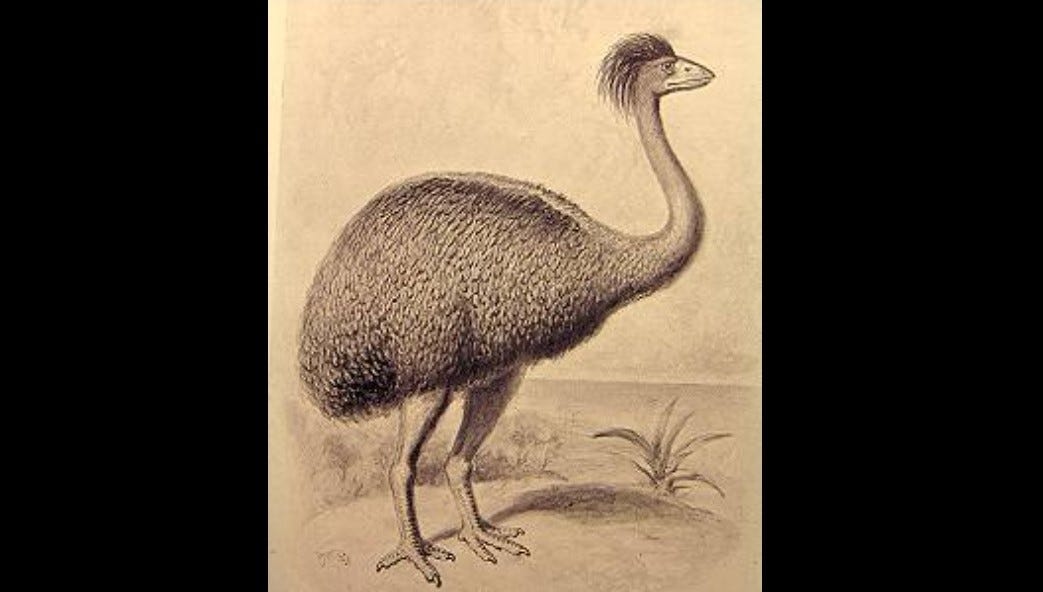Elephant Birds
Madagascar, located off the southeastern coast of Africa, is the world’s oldest island. It split off from Africa and India roughly 80-100 million years ago. As is typically the case with island ecosystems, Madagascar is home to a wide array of unique wildlife. Amazingly, approximately 90% of the island’s plant and animal life is found nowhere else in the world.
It was here that, until relatively recently, some of the largest birds who ever existed lived—elephant birds.
Aepyornithiformes
Belonging to the order Aepyornithiformes, elephant birds were part of a group of flightless birds known as ratites—a group which also includes ostriches, cassowaries, kiwis, emus and the extinct moa.
They were herbivorous, their diet consisting of leaves, seeds, and fruit. These birds favored the secluded forested areas of the island. The structure of their optic lobes indicates that elephant birds likely led either a nocturnal or crepuscular (most active at dawn and dusk) lifestyle.
It is believed that these large birds were once widespread and could be found throughout much of Madagascar.
Confusion Over Genera
Mullerornis and Aepyornis are the two accepted genera of elephant birds. As many as 11 species have been attributed to the genus Aepyornis, but only two are currently considered valid: A. maximus and A. hildebrandti.
Conversely, Mullerornis is a monotypic genus, meaning that it contains only one species—M. modestus.
The lineages of these two genera diverged approximately 27 million years ago.
In 2018, a scientific study put forth the idea that a third genus of elephant bird had also existed: Vorombe titan (“big bird” in Greek and Malagasy).
V. titan was the largest of the elephant birds—and perhaps the largest bird of all time—growing up to 10 feet tall and weighing as much as 1,900 lbs.
“Elephant birds were the biggest of Madagascar’s megafauna and arguably one of the most important in the island’s evolutionary history – even more so than lemurs,” said Dr. James Hanford, lead author of the study.
Hanford went on to explain:
“This is because large-bodied animals have an enormous impact on the wider ecosystem they live in via controlling vegetation through eating plants, spreading biomass and dispersing seeds through defecation.”
However, more recent DNA studies have revealed that V. titan was virtually genetically indistinguishable from A. maximus and may in fact represent the female of this species, rather than an entirely different genus. As is the case with many other ratites, female elephant birds are believed to have been larger than the males.
“At the time of their extinction there were likely three species belonging to two different families, and this was supported by both the genetic and protein results,” explained researcher Alicia Grealy in 2023. “Although skeletal morphology had suggested there were more species, we think this was due to extreme differences between males and females of the same species.”
The Largest Eggs Ever Found
The eggs of elephant birds are the largest that have ever been discovered. They reached an incredible size of 10-16 inches long and 7.5 to 9.8 inches wide (compare this to the size of an ostrich egg, which comes in at just under 6 inches long and 5.1 inches wide).
A fascinating study was conducted which analyzed 960 fragments of elephant bird eggs, which were anywhere from 1,300 to 6,200 years old.
“The eggshells look like pottery,” noted Professor Gifford Miller, one of the study’s co-authors. “They’re so strong – they’re not at all fragile.”
“Based on the analysis of some newly discovered eggshell fragments, we think there was a separate sub-species living in the north of Madagascar,” said Grealy.
This came as a surprise to the team, as no fossils of these birds have yet been found on that part of the island.

When Did They Go Extinct?
The elephant bird’s closest living relative is the kiwi of New Zealand. Their lineages diverged roughly 54 million years ago.
When elephant birds ultimately vanished—and the cause for their extinction—is still a mystery. It has been estimated that they were extinct by around AD 1000, but some historical evidence suggests that remnant populations might have survived until much later.
Explorer Marco Polo journeyed to the island in the 13th century and recorded accounts that he’d heard of the giant birds who still lived there.
Étienne de Flacourt, French governor of Madagascar in the mid-17th century, spoke of “vouropatra”—big ostrich-like birds that occupied the isolated areas of the island.
The “vouropatra – a large bird which haunts the Ampatres (a nomadic group) and lays eggs like the ostriches; so that the people of these places may not take it, it seeks the most lonely places,” wrote Flacourt in 1659.
Whether Flacourt was referencing an actual bird or rather just a mythological one is still a matter of debate.
Interestingly, some have speculated that the roc of Middle Eastern mythology—an enormous bird of prey said to be strong enough to carry an elephant—was inspired by the elephant bird.
Additionally, Europeans who visited Madagascar between 1830-1840 reportedly came across a large number of their eggs during their time there. While the veracity of these accounts can’t be substantiated, it’s certainly amazing to think that these incredible animals might have still been present that recently.
In terms of what drove them to extinction, factors such as human activity, deforestation, and climate change have been proposed. But ultimately, the cause is still unknown.
Little evidence has been found to suggest overhunting by humans, though.
“Humans seem to have coexisted with elephant birds and other now-extinct species for over 9,000 years, apparently with limited negative impact on biodiversity for most of this period,” Dr. James Hanford pointed out, “which offers new insights for conservation today.”
Hopefully, more discoveries in the future will bring us closer to understanding these birds and their downfall.





